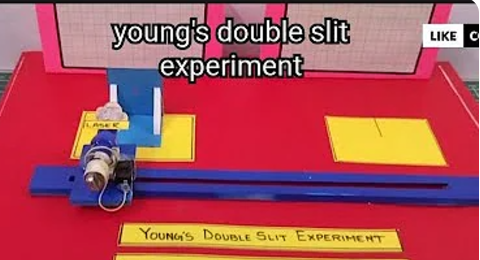
Creating a young’s double slit Experiment Working Model Demonstration
| Materials | Required |
|---|---|
| 1. Card Board | 2. Laser Light |
| 3. Pastel sheet | 4. Graph Paper |
| 5. Slit – thin copper wire | 6. Glue and Hot glue gun |
Table of Contents
Table of Contents
Steps to Make the Model
Step 1: Create the Double Slit
Take the cardboard sheet or dark outline paper and cut a square shape.
Utilize a sharp cutting edge to painstakingly make two meager, equal slits around 1 mm separated.
Make sure the slits are extremely near one another and equivalent in size.
The slits ought to be essentially as slim as conceivable to get clear examples.
Step 2: Set Up the Laser Pointer
Fix your laser pointer on a little stand with the goal that it remains predictable.
You can utilize a heap of books or mud to hold it set up.
Position the laser pointer with the goal that it focuses straightforwardly at the slits in your cardboard.
Step 3: Arrange the Screen
Place a clear white wall or a huge piece of white paper a couple of feet behind the cardboard with the slits.
Make sure the laser pointer, the slits, and the screen are adjusted in an orderly fashion.
Step 4: Conduct the Experiment
Switch out the lights in the space to make it hazier. This will assist you with seeing the impedance design all the more obviously.
Switch on the laser pointer and hold back nothing the slits.
Notice the example formed on the white wall or screen. You ought to see exchanging splendid and dull groups. These are the impedance borders.
Related – Reflactive index of different liquid using hollow prism
How It Works
At the point when the laser light goes through the two slits:
The light waves from each slit cross-over and obstruct one another.
Where the waves meet and reinforce one another, you see splendid spots (useful obstruction).
Where the waves offset one another, you see dim spots (damaging obstruction).
This demonstrates that light acts like waves!
Tips for Success
Utilize an exceptionally dainty edge to make spotless, sharp slits.
Save the laser pointer consistent for the best outcomes.
Take a stab at changing the distance between the slits and the screen to perceive how it changes the example.
Who Was Thomas Young?
Thomas Young was a scientist brought into the world in 1773 in Britain. He was keen on numerous things, including physical science, science, and dialects. One of his greatest commitments to science was his work on seeing light.
At the time, there were two main ideas about light:
Isaac Newton’s Particle Theory: Newton accepted that light was comprised of small particles that went in straight lines.
Wave Theory of Light: Other scientists thought light acted like waves, like waves on water.
Young’s Double Slit Experiment demonstrated that light acts like a wave.
- Solar Cell Working Model – 1 Simple DIY Model for Students
- Area of Circle Working Model ✨
- Young’s double slit experiment Model
- Conic Section Working Model📐
- biosphere 3D model
What is Light?
Light is a kind of energy that permits us to see our general surroundings. It voyages extremely quick — at a speed of about 300,000 kilometers each second!
Light can:
Go through space.
Bob off objects (reflection).
Twist around corners (diffraction).
Consolidate or cancel out when waves meet (impedance).
The Double Slit Experiment assists us with figuring out one of these extraordinary properties: impedance.
Thanks for Reading the Article, please feel free to comment us or contact us on shakunkumar55@gmail.com
Visit our Youtube Channel for model making videos and projects content.
FAQ
What Is the Double Slit Experiment?
Imagine focusing light through two little cuts (like little openings). What might occur? You could anticipate two splendid spots on a screen behind the cuts. However, when Thomas Youthful attempted this, he saw something astonishing — an example of numerous brilliant and dim lines on the screen.
This odd example is called an impedance example, and it happens on the grounds that light acts like a wave.